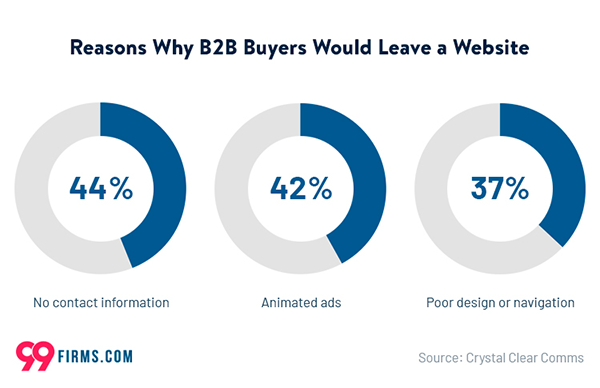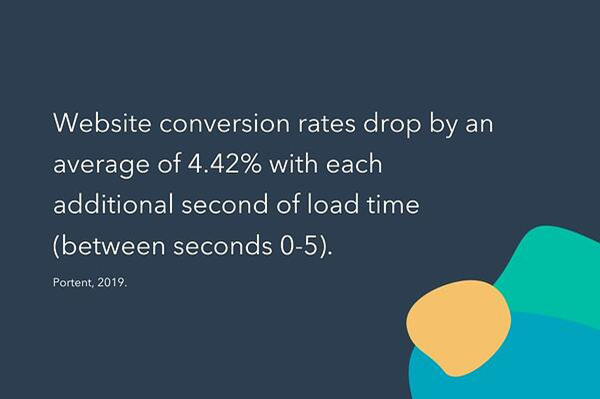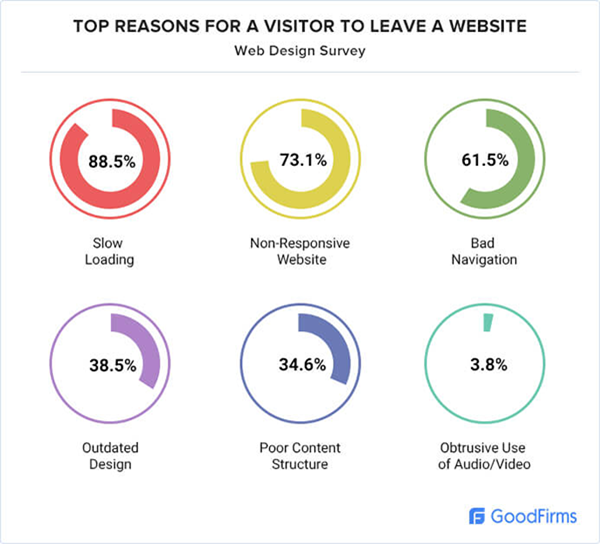10 Reasons Why You Should Consider Redesigning Your Website
You launched your website five years ago, and it’s been running on autopilot ever since. While you might have started off with a great conversion rate, it’s likely to have slipped - especially if you haven’t considered the benefits of personalizing websites or optimizing them for mobile.
No matter how well you think you’re doing, it’s always worth taking a step back and reassessing. Here are 10 reasons why you should consider redesigning your website:
Unsatisfactory Website Performance
When you’re thinking about redesigning your website, your first step should be to determine what’s wrong with it. Ask yourself what your goals are and if they’re being met by your website. Consider things like conversion rates, time spent on site, bounce rate, and cart abandonment.
Once you identify the problem you want to solve, it’s time to look into your CX analytics, as well as ask for feedback. Figure out why you’re not getting the results you want. For instance, are lots of customers leaving at the checkout stage? If so, it might be a problem with your payment options. Alternatively, if they’re leaving as soon as they reach your landing page, you probably have a larger design problem.

source: 99Firms
Redesigning your website gives you the chance to find these pain points and improve them - saving time and boosting profits long term.
Increase Page Speed
The best conversion rates happen when your page loads in less than two seconds. If your site takes longer than that, it’s time for a redesign. Not only will potential customers leave over low load times, but Google will rank you lower in search results too.

source: HubSpot
But how can you fix this? Firstly, check your current speed. If it looks like it needs to improve, implement some of these common measures:
Optimize images
The larger your image sizes, the longer it will take for your page to load. Compress your images and upload the right size to avoid slowing down your page speed.
Remove unnecessary plugins
Each additional plugin on your site adds to page loading time. While some plugins provide more functionality to your site, not all are necessary. Removing unneeded plugins is a great way to boost your page speed.
Compress website code
Compressing your website code to its most basic size can make a big difference. Look into options like HTMLMinifier, CSSNano, and UglifyJS.
Make Your Website Mobile Responsive
Over 50% of the world’s web traffic comes from mobile devices. This is why your website must be optimized for viewing on smartphones and tablets.
A website that is not mobile responsive will require tedious screen pinching and zooming in and out for use. This is inconvenient and is likely to drive customers away - especially if your competitors do have mobile-optimized websites.
Making your website mobile responsive is a key part of improving digital accessibility. A mobile responsive website changes the look and layout of the page based on the device it is viewed on, providing website visitors with an optimum user experience across devices. So whether you’re accessing a website on your laptop, tablet, or smartphone, you should be able to access all its features with the same ease.
The typical design elements considered while optimizing a website for mobile responsiveness are:
- Creating ample space for tap targets
- Eliminating horizontal scrolling
- Increased font size and reduced image size
- Minimal data required for loading
Ensure Your Website is Secure
Website security is one of the top concerns for businesses around the world. This is both to protect themselves and site visitors from possible cyber threats. Google and other search engines can downrank your website if it’s marked insecure without SSL. Websites that have been built over a year ago and haven’t been updated since are particularly prone to these threats.

source: Statista
Cybercrime is expected to cost the global economy $10.5 trillion by 2025. This stat should be reason enough for you to review the security features of your website! The threat is especially high for ecommerce businesses that deal with sensitive customer information. One chink in your security armor, and all your confidential data can be leaked - losing you money and customer trust.
Redesigning your website’s security framework is a vital step in safeguarding your cyber security. A secure website also instills confidence in your brand and encourages customers to engage with you.
Invest in SEO
You could have the most visually stunning website in the world, but it won’t mean much if customers can’t find you. Unless your website is search engine optimized, it’s not worth much. Search engine optimization (SEO) is the process of improving the visibility of your website and helping it rank higher in a search engine’s organic results.
If your website is not performing as well as it should, SEO could be the issue. From including relevant keywords to securing valuable backlinks, there are several on-page and off-page factors that go into SEO.
Maybe you need to review your keyword research. Use a free tool like Google Keyword Planner to find the most popular and relevant keywords for your product. This helps you create content that is tailored to fit the search criteria of potential buyers. For example, if your company provides 360 degrees QA solutions like production testing, then you need to be ranking for keywords related to that topic - for instance, ‘production testing services’, ‘production testing definition’, and ‘TIP’.
Website Not Presenting Correct Brand Image
A solid brand image is what sets your business apart and builds your credibility. Your brand should portray the essence of your business and what you stand for. You need to make sure your website presents an accurate image of your company, whether through the aesthetic elements of your design or your brand’s tone of voice.

source: Unsplash
Your brand image and messaging need to be consistent across both online and offline platforms. You don’t want to come across as a fun, youthful company on Instagram only to seem very serious and technical on your website, for instance.
Redesigning your website becomes necessary when it’s failing to present a clear image of your brand lacking synchronicity with our other communication channels.
Improve Dated Web Design
We’ve all clicked through to something then clicked away because it looks like no one has touched it since the 90s. A dated website can make you look out of touch and even raise questions of whether you’re still in business!
You don’t have to follow every trend - and you definitely want to stand out from your competitors - but make sure your website feels contemporary. A good place to start is to compare it to others in your field and make sure it doesn’t feel five years behind.
Unclear Site Navigation
Another important reason to redesign your website is to assess your site navigation. A well-structured navigation feature lets users move seamlessly from one element of the site to another. Given that an estimated 76% of users say that the most important element of a website is that it makes it easy for them to find things, this isn’t something to ignore.

source: GoodFirms
Site navigation should be clear and organic. One way to improve your site navigation is to de-clutter your main menu. Too many choices can be confusing for users and also affect your page’s UI from a design perspective. Try to restrict options to a maximum of five or six. This makes it easier to find and click through to what users want to access.
Site navigation is also improved by displaying related content. Let’s say a user has read a blog post on your site about sales revenue. Displaying a thumbnail of a related post on sales commission structures may be useful to them. These intuitive suggestions also help users explore more of your content and be seamlessly directed from one point to the next.
Implement an Easy-to-Use CMS
The content management system (CMS) that you use should be user-friendly while also being robust. You should be able to upload content and access data without involving your IT team, making it easy to manage minor edits and updates on your website.
Having a strong but easy-to-use CMS is the first step in your web design journey and something to assess when you’re planning a site overhaul. Do your research and find out how to choose a content management system that’s right for you.
Boost User Engagement
Finally, users must get some value from your website to keep coming back. You don’t want a single visit - you want repeat customers. One excellent way to achieve this is through a steady output of good-quality content that informs and educates about industry-related topics. Another is through ensuring customers feel taken care of.
Consider the main objectives of customer service, and make sure you meet them. Quick response times? Invest in a chatbot. Lots of questions? Set up an FAQ page. By providing an excellent customer experience, you can boost engagement - and sales.
So What Now?
Hopefully, you now have a better idea of why you should consider redesigning your website. The term design is commonly associated with aesthetics, but website design involves everything from SEO optimization to page load speed. So, whether you need to better secure your website or create a smoother navigation and UX for customers, a strategic website redesign can help you achieve your goals

Jenna Bunnell
Jenna Bunnell is the Senior Manager for Content Marketing at Dialpad, an AI-incorporated cloud-hosted unified communications system that offers cloud PBX for small business and provides valuable call details for business owners and sales representatives. She is driven and passionate about communicating a brand’s design sensibility and visualizing how content can be presented in creative and comprehensive ways.